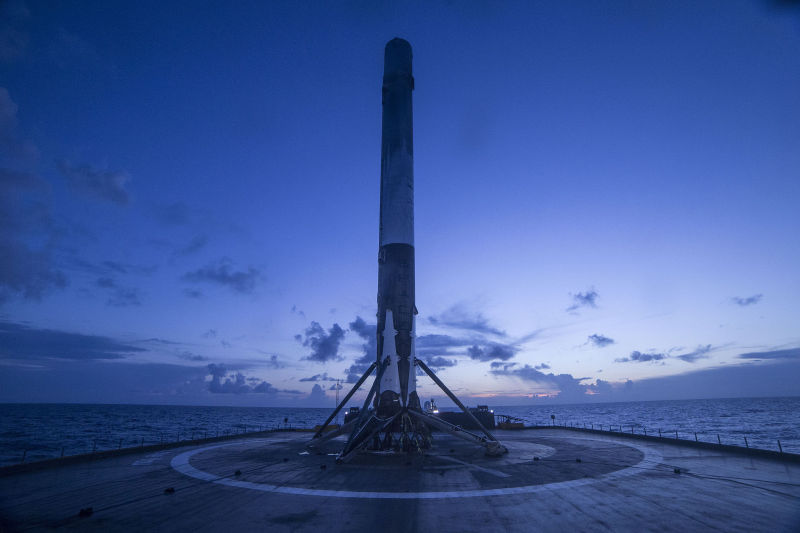Social network giant under EU pressure for not editing hateful and illegal posts.
Company has shown it can land rockets, but now it needs to fly them again.

Intel began shipping 7th-gen Core chips to device makers this summer, and now the company is finally ready to explain what makes the new processors tick.
The company is launching new 4.5 watt and 15 watt, dual-core chips based on “Kaby Lake” architecture. They’re expected to show up in laptops, 2-in-1 tablets, and low-power desktops in the coming months.
Expect to see a lot of Kaby Lake-powered devices announced at the IFA show in Berlin this week.
Continue reading Kaby Lake is here: Intel launches 7th-gen Core chips for laptops and 2-in-1 tablets at Liliputing.


Intel began shipping 7th-gen Core chips to device makers this summer, and now the company is finally ready to explain what makes the new processors tick.
The company is launching new 4.5 watt and 15 watt, dual-core chips based on “Kaby Lake” architecture. They’re expected to show up in laptops, 2-in-1 tablets, and low-power desktops in the coming months.
Expect to see a lot of Kaby Lake-powered devices announced at the IFA show in Berlin this week.
Continue reading Kaby Lake is here: Intel launches 7th-gen Core chips for laptops and 2-in-1 tablets at Liliputing.

Derzeit startet die offene Beta von Battlefield 1 – mit unterschiedlichen Bedingungen für Nutzer der Playstation 4 und Xbox Live: Nur auf einem der beiden Systeme ist keine kostenpflichtige Mitgliedschaft nötig. (Battlefield, Electronic Arts) 

Derzeit startet die offene Beta von Battlefield 1 - mit unterschiedlichen Bedingungen für Nutzer der Playstation 4 und Xbox Live: Nur auf einem der beiden Systeme ist keine kostenpflichtige Mitgliedschaft nötig. (
Battlefield,
Electronic Arts)

Infant simulators didn’t curb teen pregnancy and may promote early parenthood.
Verbesserte Fertigung, schnellerer Turbo und volle Hardware-Beschleunigung für H.265- sowie VP9-Videos: Kaby Lake ist etwas mehr als ein Refresh von Skylake. Das macht die neuen Chips interessant für 4K-UHD-Streaming, egal ob in lokalen oder mobilen Geräten. (Kaby Lake, Prozessor) 

Verbesserte Fertigung, schnellerer Turbo und volle Hardware-Beschleunigung für H.265- sowie VP9-Videos: Kaby Lake ist etwas mehr als ein Refresh von Skylake. Das macht die neuen Chips interessant für 4K-UHD-Streaming, egal ob in lokalen oder mobilen Geräten. (
Kaby Lake,
Prozessor)

New 7th-generation Core CPUs have a lot in common with the 6th generation.
Die Ankündigung von Whatsapp, künftig die Telefonnummer der Nutzer mit Facebook zu teilen, hat bei vielen Nutzern für Empörung gesorgt. Andere Messenger scheinen davon zu profitieren. (Threema, Datenschutz) 

Die Ankündigung von Whatsapp, künftig die Telefonnummer der Nutzer mit Facebook zu teilen, hat bei vielen Nutzern für Empörung gesorgt. Andere Messenger scheinen davon zu profitieren. (
Threema,
Datenschutz)

Google hat in seinen Webbrowser Chrome die Übertragungstechnologie Google Cast fest eingebaut. Ein Plugin ist ab sofort nicht mehr nötig, um Musik oder Videos an ein Cast-fähiges Gerät zu streamen. (Google, Browser) 

Google hat in seinen Webbrowser Chrome die Übertragungstechnologie Google Cast fest eingebaut. Ein Plugin ist ab sofort nicht mehr nötig, um Musik oder Videos an ein Cast-fähiges Gerät zu streamen. (
Google,
Browser)

A simple upgrade to support a new OS shouldn’t cost you, VMware says.



 Derzeit startet die offene Beta von Battlefield 1 - mit unterschiedlichen Bedingungen für Nutzer der Playstation 4 und Xbox Live: Nur auf einem der beiden Systeme ist keine kostenpflichtige Mitgliedschaft nötig. (
Derzeit startet die offene Beta von Battlefield 1 - mit unterschiedlichen Bedingungen für Nutzer der Playstation 4 und Xbox Live: Nur auf einem der beiden Systeme ist keine kostenpflichtige Mitgliedschaft nötig. (
 Verbesserte Fertigung, schnellerer Turbo und volle Hardware-Beschleunigung für H.265- sowie VP9-Videos: Kaby Lake ist etwas mehr als ein Refresh von Skylake. Das macht die neuen Chips interessant für 4K-UHD-Streaming, egal ob in lokalen oder mobilen Geräten. (
Verbesserte Fertigung, schnellerer Turbo und volle Hardware-Beschleunigung für H.265- sowie VP9-Videos: Kaby Lake ist etwas mehr als ein Refresh von Skylake. Das macht die neuen Chips interessant für 4K-UHD-Streaming, egal ob in lokalen oder mobilen Geräten. ( Die Ankündigung von Whatsapp, künftig die Telefonnummer der Nutzer mit Facebook zu teilen, hat bei vielen Nutzern für Empörung gesorgt. Andere Messenger scheinen davon zu profitieren. (
Die Ankündigung von Whatsapp, künftig die Telefonnummer der Nutzer mit Facebook zu teilen, hat bei vielen Nutzern für Empörung gesorgt. Andere Messenger scheinen davon zu profitieren. ( Google hat in seinen Webbrowser Chrome die Übertragungstechnologie Google Cast fest eingebaut. Ein Plugin ist ab sofort nicht mehr nötig, um Musik oder Videos an ein Cast-fähiges Gerät zu streamen. (
Google hat in seinen Webbrowser Chrome die Übertragungstechnologie Google Cast fest eingebaut. Ein Plugin ist ab sofort nicht mehr nötig, um Musik oder Videos an ein Cast-fähiges Gerät zu streamen. (